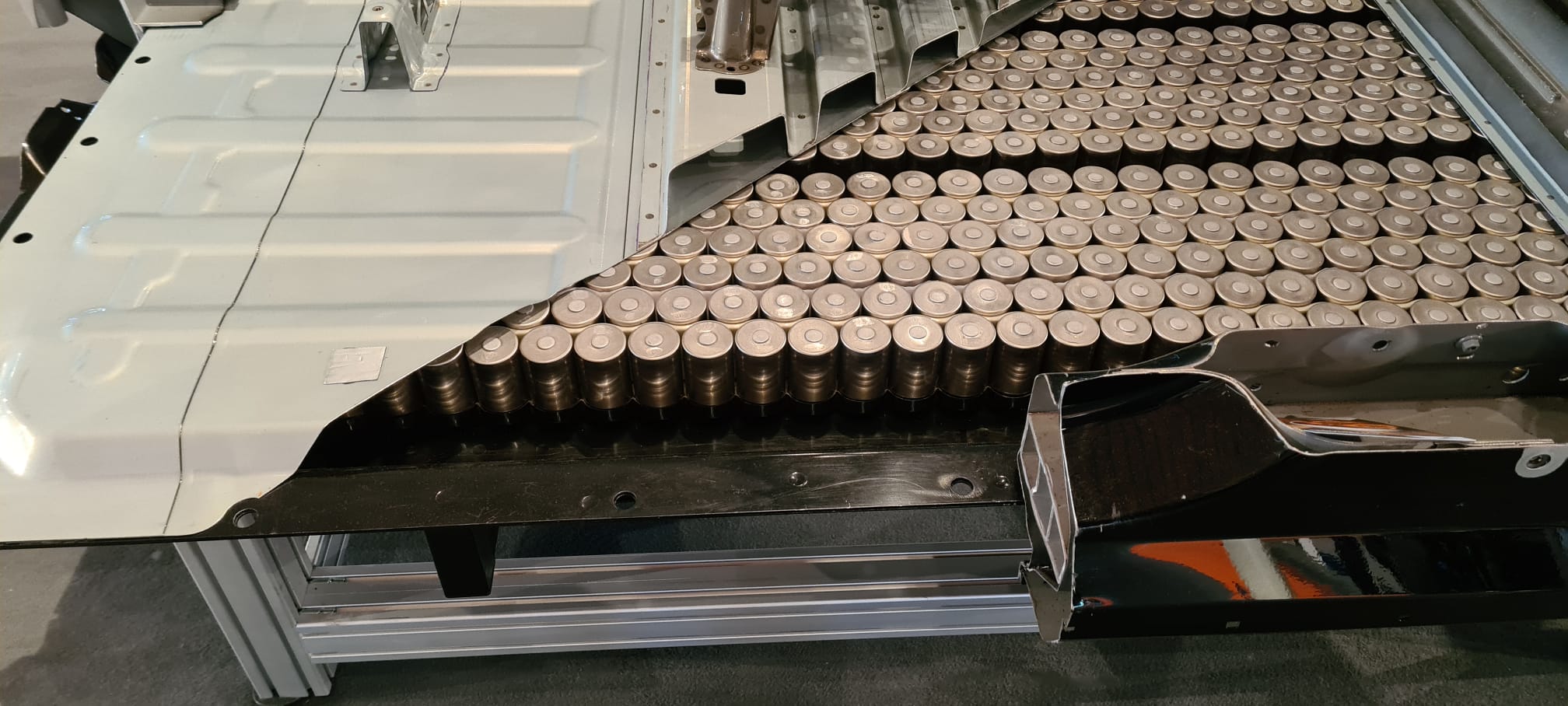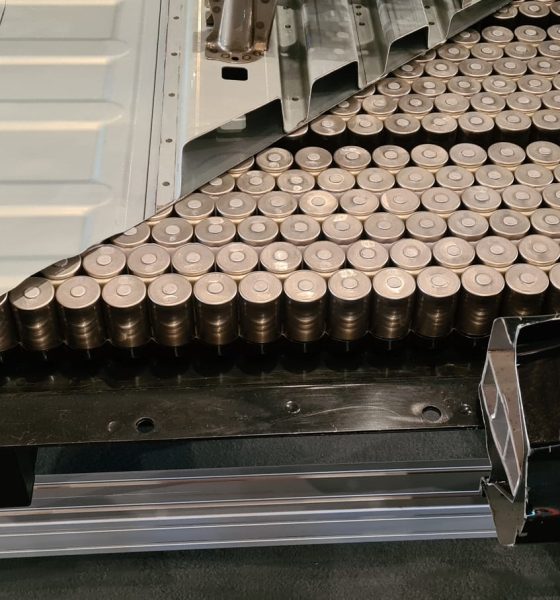Tesla has been pretty open about the idea that its next-generation of vehicles and its 20 million EV target for 2030 would rely on its ability to scale its 4680 battery production. This task, at least according to experts, has proven to be especially challenging.
Unveiled during Battery Day nearly two years ago, 4680 cells are expected to provide Tesla with substantial manufacturing cost reductions and efficiencies. According to statements from several experts in the field, the use of larger cells and a dry-coat electrode process could enable Tesla to halve the cost of a Model Y battery.
Twelve experts who are reportedly close to Tesla, or at least familiar with the company’s new battery technology, shared their insights with Reuters. Among the 12 experts, nine reportedly have close ties to Tesla, while three have examined the company’s previous battery technology thoroughly through an extensive teardown.
According to the publication’s sources, Tesla is only halfway towards its goal of successfully rolling out its 4680 cells. While the EV maker already sees benefits from the use of larger cells, Tesla is still reportedly seeing challenges with scaling its dry-coat electrode process.
This, according to the experts, was because Tesla’s dry-coat electrode process is so new and unproven that the company is still having trouble scaling its operations to the point where savings become substantial. Still, the publication’s sources have stated that Tesla would probably still be able to fully implement its 4680 cells’ dry coat electrode process next year.
2019 Nobel laureate and lithium-ion battery pioneer Stan Whittingham believes that Tesla would ultimately solve the challenges associated with its 4680 battery production ramp, though he also noted that Elon Musk might have been too optimistic with his target timeframe for the next-generation batteries’ rollout. “I think he will solve it, but it won’t be as quick as he likes. It’s going to take some time to really test it,” Whittingham said.
Reuters‘ sources noted that if all the potential efficiencies from the use of 4680 batteries are realized, the manufacturing cost for the Model Y’s 4680 structural battery could fall to just about $5,000-$5,500 — roughly half the cost of a 2170 pack. So far, Tesla is reportedly seeing about $2,000 to $3,000 worth of cost savings, mainly due to its use of bigger cells.
With Tesla’s 2170 battery packs, the company reportedly uses about 4,400 cells for the Model Y. The 2170 packs also require 17,600 points that need to be welded — about four welds per cell — to create a battery that can be integrated into the all-electric crossover. This is reduced significantly with the use of 4680 cells. The experts noted that Tesla only needs 830 cells for its Model Y 4680 structural pack, and since there are only two weld points for each cell, the total weld points per vehicle drops to just 1,660 points.
But while Tesla has made tons of headway with its 4680 batteries, and while the company already sees savings due to its use of larger cells, the EV maker still needs to master and scale its dry electrode process. Once that’s done, Tesla could effectively attain the holy grail of its next-generation batteries. “Bulking up the battery cell helped a lot in boosting efficiency, but pushing for 50% cost savings for the cell as a whole is another matter. That will depend on whether Tesla can deploy the dry-coating process successfully in a factory,” one of Reuters‘ sources said.
Don’t hesitate to contact us with news tips. Just send a message to simon@teslarati.com to give us a heads up.

News
Elon Musk’s Grokipedia surges to 5.6M articles, almost 79% of English Wikipedia
The explosive growth marks a major milestone for the AI-powered online encyclopedia, which was launched by Elon Musk’s xAI just months ago.

Elon Musk’s Grokipedia has grown to an impressive 5,615,201 articles as of today, closing in on 79% of the English Wikipedia’s current total of 7,119,376 articles.
The explosive growth marks a major milestone for the AI-powered online encyclopedia, which was launched by Elon Musk’s xAI just months ago. Needless to say, it would only be a matter of time before Grokipedia exceeds English Wikipedia in sheer volume.
Grokipedia’s rapid growth
xAI’s vision for Grokipedia emphasizes neutrality, while Grok’s reasoning capabilities allow for fast drafting and fact-checking. When Elon Musk announced the initiative in late September 2025, he noted that Grokipedia would be an improvement to Wikipedia because it would be designed to avoid bias.
At the time, Musk noted that Grokipedia “is a necessary step towards the xAI goal of understanding the Universe.”
Grokipedia was launched in late October, and while xAI was careful to list it only as Version 0.1 at the time, the online encyclopedia immediately earned praise. Wikipedia co-founder Larry Sanger highlighted the project’s innovative approach, noting how it leverages AI to fill knowledge gaps and enable rapid updates. Netizens also observed how Grokipedia tends to present articles in a more objective manner compared to Wikipedia, which is edited by humans.
Elon Musk’s ambitious plans
With 5,615,201 total articles, Grokipedia has now grown to almost 79% of English Wikipedia’s article base. This is incredibly quick, though Grokipedia remains text-only for now. xAI, for its part, has now updated the online encyclopedia’s iteration to v0.2.
Elon Musk has shared bold ideas for Grokipedia, including sending a record of the entire knowledge base to space as part of xAI’s mission to preserve and expand human understanding. At some point, Musk stated that Grokipedia will be renamed to Encyclopedia Galactica, and it will be sent to the cosmos.
“When Grokipedia is good enough (long way to go), we will change the name to Encyclopedia Galactica. It will be an open source distillation of all knowledge, including audio, images and video. Join xAI to help build the sci-fi version of the Library of Alexandria!” Musk wrote, adding in a later post that “Copies will be etched in stone and sent to the Moon, Mars and beyond. This time, it will not be lost.”
News
Tesla Model 3 becomes Netherlands’ best-selling used EV in 2025
More than one in ten second-hand electric cars sold in the country last year was a Tesla Model 3.

The Tesla Model 3 became the most popular used electric car in the Netherlands in 2025, cementing its dominance well beyond the country’s new-car market.
After years at the top of Dutch EV sales charts, the Model 3 now leads the country’s second-hand EV market by a wide margin, as record used-car purchases pushed electric vehicles further into the mainstream.
Model 3 takes a commanding lead
The Netherlands recorded more than 2.1 million used car sales last year, the highest level on record. Of those, roughly 4.8%, or about 102,000 vehicles, were electric. Within that growing segment, the Tesla Model 3 stood far ahead of its competitors.
In 2025 alone, 11,338 used Model 3s changed hands, giving the car an 11.1% share of the country’s entire used EV market. That means more than one in ten second-hand electric cars sold in the country last year was a Tesla Model 3, Auto Week Netherlands reported. The scale of its lead is striking: the gap between the Model 3 and the second-place finisher, the Volkswagen ID3, is more than 6,700 vehicles.
Rivals trail as residual values shape rankings
The Volkswagen ID.3 ranked a distant second, with 4,595 used units sold and a 4.5% market share. Close behind was the Audi e-tron, which placed third with 4,236 registrations. As noted by Auto Week Netherlands, relatively low residual values likely boosted the e-tron’s appeal in the used market, despite its higher original price.
Other strong performers included the Kia Niro, the Tesla Model Y, and the Hyundai Kona, highlighting continued demand for compact and midsize electric vehicles with proven range and reliability. No other model, however, came close to matching the Model 3’s scale or market presence.
News
Tesla Model Y Standard Long Range RWD launches in Europe
The update was announced by Tesla Europe & Middle East in a post on its official social media account on X.

Tesla has expanded the Model Y lineup in Europe with the introduction of the Standard Long Range RWD variant, which offers an impressive 657 km of WLTP range.
The update was announced by Tesla Europe & Middle East in a post on its official social media account on X.
Model Y Standard Long Range RWD Details
Tesla Europe & Middle East highlighted some of the Model Y Standard Long Range RWD’s most notable specs, from its 657 km of WLTP range to its 2,118 liters of cargo volume. More importantly, Tesla also noted that the newly released variant only consumes 12.7 kWh per 100 km, making it the most efficient Model Y to date.
The Model Y Standard provides a lower entry point for consumers who wish to enter the Tesla ecosystem at the lowest possible price. While the Model 3 Standard is still more affordable, some consumers might prefer the Model Y Standard due to its larger size and crossover form factor. The fact that the Model Y Standard is equipped with Tesla’s AI4 computer also makes it ready for FSD’s eventual rollout to the region.
Top Gear’s Model Y Standard review
Top Gear‘s recent review of the Tesla Model Y Standard highlighted some of the vehicle’s most notable features, such as its impressive real-world range, stellar infotainment system, and spacious interior. As per the publication, the Model Y Standard still retains a lot of what makes Tesla’s vehicles well-rounded, even if it’s been equipped with a simplified interior.
Top Gear compared the Model Y Standard to its rivals in the same segment. “The introduction of the Standard trim brings the Model Y in line with the entry price of most of its closest competition. In fact, it’s actually cheaper than a Peugeot e-3008 and costs £5k less than an entry-level Audi Q4 e-tron. It also makes the Ford Mustang Mach-E look a little short with its higher entry price and worse range,” the publication wrote.










